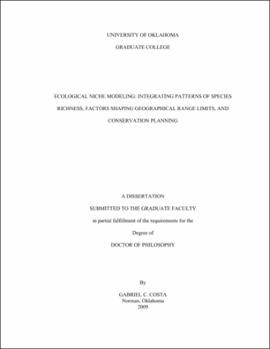| dc.description.abstract | The concept of the niche has been a central theme of ecology for over half a century. With recent advances in Geographic Information Systems (GIS) and statistical procedures, the inferential method of ecological niche modeling (ENM) has emerged as an important tool for studies in ecology and evolutionary biology. This method consists of modeling species' distributions based on attributes of the environment that should be correlated with species' niche requirements. The models assume that geographic distribution and characteristics of the environment are related to the species niche, and therefore are tied to ecological niche theory. Over the past several years, ENM has been widely used to address numerous research questions in ecology, evolutionary biology, and conservation. Here I applied ENM in novel ways, focusing on central themes in Macroecology, Biogeography, and Conservation. First, I analyzed species richness in the Brazilian Cerrado, identifying areas of high richness and analyzing the relationship between richness and climatic variables to test predictions of large-scale hypotheses concerning determinants of species richness. Second, I assessed the performance of two ENM algorithms in predicting species richness and composition of an unsampled area of conservation interest in the Brazilian Cerrado. These analyses provided an overall assessment of the weaknesses and strengths of ENM for conservation planning. Lastly, I applied ENM to two different situations in an effort to understand and disentangle the relative contributions of abiotic factors, competition, dispersal barriers, and biotic interactions in determining species' range limits. Overall, I was able to show that by applying ENM techniques it is possible to gain insights into a vast number of ecological questions. These studies highlight the complexity of studying species range limits, but reiterate that an integrative approach is necessary to understand this phenomenon. | |
